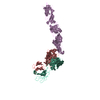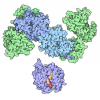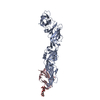[English] 日本語
 Yorodumi
Yorodumi- EMDB-5102: Immature Dengue Virus (DENV) in complex with Fab fragments of the... -
+ Open data
Open data
- Basic information
Basic information
| Entry | Database: EMDB / ID: EMD-5102 | |||||||||
|---|---|---|---|---|---|---|---|---|---|---|
| Title | Immature Dengue Virus (DENV) in complex with Fab fragments of the anti-fusion loop antibody E53 | |||||||||
 Map data Map data | CryoEM reconstruction of immature Dengue Virus (DENV) in complex with Fab fragments of the anti-fusion loop antibody E53. | |||||||||
 Sample Sample |
| |||||||||
 Keywords Keywords | Dengue Virus / DENV / immature / fusion loop / Fab / E53 | |||||||||
| Function / homology |  Function and homology information Function and homology informationflavivirin / host cell mitochondrion / symbiont-mediated suppression of host JAK-STAT cascade via inhibition of host TYK2 activity / symbiont-mediated suppression of host JAK-STAT cascade via inhibition of STAT2 activity / symbiont-mediated suppression of host cytoplasmic pattern recognition receptor signaling pathway via inhibition of MAVS activity / ribonucleoside triphosphate phosphatase activity / viral capsid / double-stranded RNA binding / nucleoside-triphosphate phosphatase / channel activity ...flavivirin / host cell mitochondrion / symbiont-mediated suppression of host JAK-STAT cascade via inhibition of host TYK2 activity / symbiont-mediated suppression of host JAK-STAT cascade via inhibition of STAT2 activity / symbiont-mediated suppression of host cytoplasmic pattern recognition receptor signaling pathway via inhibition of MAVS activity / ribonucleoside triphosphate phosphatase activity / viral capsid / double-stranded RNA binding / nucleoside-triphosphate phosphatase / channel activity / viral nucleocapsid / monoatomic ion transmembrane transport / mRNA (guanine-N7)-methyltransferase / clathrin-dependent endocytosis of virus by host cell / methyltransferase cap1 / molecular adaptor activity / methyltransferase cap1 activity / mRNA 5'-cap (guanine-N7-)-methyltransferase activity / RNA helicase activity / protein dimerization activity / host cell perinuclear region of cytoplasm / symbiont-mediated suppression of host innate immune response / host cell endoplasmic reticulum membrane / RNA helicase / symbiont-mediated suppression of host type I interferon-mediated signaling pathway / symbiont-mediated activation of host autophagy / RNA-directed RNA polymerase / serine-type endopeptidase activity / viral RNA genome replication / RNA-directed RNA polymerase activity / fusion of virus membrane with host endosome membrane / viral envelope / lipid binding / virion attachment to host cell / host cell nucleus / virion membrane / structural molecule activity / ATP hydrolysis activity / proteolysis / extracellular region / ATP binding / metal ion binding / membrane Similarity search - Function | |||||||||
| Biological species | Immature Dengue Virus | |||||||||
| Method | single particle reconstruction / cryo EM / Resolution: 23.0 Å | |||||||||
 Authors Authors | Cherrier MV / Kaufmann B / Nybakken GE / Lok SM / Warren JT / Nelson CA / Kostyuchenko VA / Holdaway HA / Chipman PR / Kuhn RJ ...Cherrier MV / Kaufmann B / Nybakken GE / Lok SM / Warren JT / Nelson CA / Kostyuchenko VA / Holdaway HA / Chipman PR / Kuhn RJ / Diamond MS / Rossmann MG / Fremont DH | |||||||||
 Citation Citation |  Journal: EMBO J / Year: 2009 Journal: EMBO J / Year: 2009Title: Structural basis for the preferential recognition of immature flaviviruses by a fusion-loop antibody. Authors: Mickaël V Cherrier / Bärbel Kaufmann / Grant E Nybakken / Shee-Mei Lok / Julia T Warren / Beverly R Chen / Christopher A Nelson / Victor A Kostyuchenko / Heather A Holdaway / Paul R ...Authors: Mickaël V Cherrier / Bärbel Kaufmann / Grant E Nybakken / Shee-Mei Lok / Julia T Warren / Beverly R Chen / Christopher A Nelson / Victor A Kostyuchenko / Heather A Holdaway / Paul R Chipman / Richard J Kuhn / Michael S Diamond / Michael G Rossmann / Daved H Fremont /  Abstract: Flaviviruses are a group of human pathogens causing severe encephalitic or hemorrhagic diseases that include West Nile, dengue and yellow fever viruses. Here, using X-ray crystallography we have ...Flaviviruses are a group of human pathogens causing severe encephalitic or hemorrhagic diseases that include West Nile, dengue and yellow fever viruses. Here, using X-ray crystallography we have defined the structure of the flavivirus cross-reactive antibody E53 that engages the highly conserved fusion loop of the West Nile virus envelope glycoprotein. Using cryo-electron microscopy, we also determined that E53 Fab binds preferentially to spikes in noninfectious, immature flavivirions but is unable to bind significantly to mature virions, consistent with the limited solvent exposure of the epitope. We conclude that the neutralizing impact of E53 and likely similar fusion-loop-specific antibodies depends on its binding to the frequently observed immature component of flavivirus particles. Our results elucidate how fusion-loop antibodies, which comprise a significant fraction of the humoral response against flaviviruses, can function to control infection without appreciably recognizing mature virions. As these highly cross-reactive antibodies are often weakly neutralizing they also may contribute to antibody-dependent enhancement and flavi virus pathogenesis thereby complicating development of safe and effective vaccines. | |||||||||
| History |
|
- Structure visualization
Structure visualization
| Movie |
 Movie viewer Movie viewer |
|---|---|
| Structure viewer | EM map:  SurfView SurfView Molmil Molmil Jmol/JSmol Jmol/JSmol |
| Supplemental images |
- Downloads & links
Downloads & links
-EMDB archive
| Map data |  emd_5102.map.gz emd_5102.map.gz | 14.7 MB |  EMDB map data format EMDB map data format | |
|---|---|---|---|---|
| Header (meta data) |  emd-5102-v30.xml emd-5102-v30.xml emd-5102.xml emd-5102.xml | 13.2 KB 13.2 KB | Display Display |  EMDB header EMDB header |
| Images |  emd_5102_1.png emd_5102_1.png | 294.8 KB | ||
| Archive directory |  http://ftp.pdbj.org/pub/emdb/structures/EMD-5102 http://ftp.pdbj.org/pub/emdb/structures/EMD-5102 ftp://ftp.pdbj.org/pub/emdb/structures/EMD-5102 ftp://ftp.pdbj.org/pub/emdb/structures/EMD-5102 | HTTPS FTP |
-Related structure data
| Related structure data |  3c6dM  3ixyMC  5103C  3i50C  3ixxC M: atomic model generated by this map C: citing same article ( |
|---|---|
| Similar structure data |
- Links
Links
| EMDB pages |  EMDB (EBI/PDBe) / EMDB (EBI/PDBe) /  EMDataResource EMDataResource |
|---|---|
| Related items in Molecule of the Month |
- Map
Map
| File |  Download / File: emd_5102.map.gz / Format: CCP4 / Size: 74.1 MB / Type: IMAGE STORED AS FLOATING POINT NUMBER (4 BYTES) Download / File: emd_5102.map.gz / Format: CCP4 / Size: 74.1 MB / Type: IMAGE STORED AS FLOATING POINT NUMBER (4 BYTES) | ||||||||||||||||||||||||||||||||||||||||||||||||||||||||||||||||||||
|---|---|---|---|---|---|---|---|---|---|---|---|---|---|---|---|---|---|---|---|---|---|---|---|---|---|---|---|---|---|---|---|---|---|---|---|---|---|---|---|---|---|---|---|---|---|---|---|---|---|---|---|---|---|---|---|---|---|---|---|---|---|---|---|---|---|---|---|---|---|
| Annotation | CryoEM reconstruction of immature Dengue Virus (DENV) in complex with Fab fragments of the anti-fusion loop antibody E53. | ||||||||||||||||||||||||||||||||||||||||||||||||||||||||||||||||||||
| Projections & slices | Image control
Images are generated by Spider. | ||||||||||||||||||||||||||||||||||||||||||||||||||||||||||||||||||||
| Voxel size | X=Y=Z: 2.69 Å | ||||||||||||||||||||||||||||||||||||||||||||||||||||||||||||||||||||
| Density |
| ||||||||||||||||||||||||||||||||||||||||||||||||||||||||||||||||||||
| Symmetry | Space group: 1 | ||||||||||||||||||||||||||||||||||||||||||||||||||||||||||||||||||||
| Details | EMDB XML:
CCP4 map header:
| ||||||||||||||||||||||||||||||||||||||||||||||||||||||||||||||||||||
-Supplemental data
- Sample components
Sample components
-Entire : Immature Dengue Virus complexed with E53 Fab
| Entire | Name: Immature Dengue Virus complexed with E53 Fab |
|---|---|
| Components |
|
-Supramolecule #1000: Immature Dengue Virus complexed with E53 Fab
| Supramolecule | Name: Immature Dengue Virus complexed with E53 Fab / type: sample / ID: 1000 Oligomeric state: T1 icosahedron with three E monomers and two Fab per asymmetric unit Number unique components: 2 |
|---|---|
| Molecular weight | Theoretical: 24.4 MDa |
-Supramolecule #1: Immature Dengue Virus
| Supramolecule | Name: Immature Dengue Virus / type: virus / ID: 1 / Name.synonym: Immature Dengue Virus / Sci species name: Immature Dengue Virus / Database: NCBI / Virus type: VIRION / Virus isolate: STRAIN / Virus enveloped: Yes / Virus empty: No / Syn species name: Immature Dengue Virus |
|---|---|
| Host (natural) | Organism:  Homo sapiens (human) / synonym: VERTEBRATES Homo sapiens (human) / synonym: VERTEBRATES |
| Molecular weight | Theoretical: 18.8 MDa |
| Virus shell | Shell ID: 1 / Diameter: 600 Å / T number (triangulation number): 1 |
-Experimental details
-Structure determination
| Method | cryo EM |
|---|---|
 Processing Processing | single particle reconstruction |
| Aggregation state | particle |
- Sample preparation
Sample preparation
| Buffer | pH: 7.6 / Details: 12 mM Tris-HCl, 120 mM NaCl, 1 mM EDTA |
|---|---|
| Vitrification | Cryogen name: ETHANE / Instrument: HOMEMADE PLUNGER Details: Vitrification instrument: Guillotine-style plunge freezeing device Method: A small vial of ethane is placed inside a larger liquid nitrogen reservoir. The grid holding a few microliters of the sample is held in place at the bottom of a plunger by the means of fine ...Method: A small vial of ethane is placed inside a larger liquid nitrogen reservoir. The grid holding a few microliters of the sample is held in place at the bottom of a plunger by the means of fine tweezers. Once the ethane in the vial is completely frozen, it needs to be slightly melted. When the liquid ethane is ready, a piece of filter paper is then pressed against the sample to blot of excess buffer, sufficient to leave a thin layer on the grid. After a predetermined time, the filter paper is removed, and the plunger is allowed to drop into the liquid ethane. Once the grid enters the liquid ethane, the sample is rapidly frozen, and the grid is transferred under liquid nitrogen to a storage box immersed liquid nitrogen for later use in the microscope. |
- Electron microscopy
Electron microscopy
| Microscope | FEI/PHILIPS CM300FEG/T |
|---|---|
| Temperature | Average: 98 K |
| Alignment procedure | Legacy - Astigmatism: live FFT / Legacy - Electron beam tilt params: 0 |
| Details | low dose |
| Date | Apr 4, 2008 |
| Image recording | Category: FILM / Film or detector model: KODAK SO-163 FILM / Digitization - Scanner: NIKON SUPER COOLSCAN 9000 / Digitization - Sampling interval: 2.69 µm / Number real images: 23 / Average electron dose: 15.0 e/Å2 / Bits/pixel: 16 |
| Tilt angle min | 0 |
| Tilt angle max | 0 |
| Electron beam | Acceleration voltage: 300 kV / Electron source:  FIELD EMISSION GUN FIELD EMISSION GUN |
| Electron optics | Calibrated magnification: 47244 / Illumination mode: FLOOD BEAM / Imaging mode: BRIGHT FIELD / Cs: 2.0 mm / Nominal defocus max: 2.728 µm / Nominal defocus min: 1.876 µm / Nominal magnification: 45000 |
| Sample stage | Specimen holder: EUCENTRIC / Specimen holder model: GATAN LIQUID NITROGEN |
- Image processing
Image processing
| Details | 400 mesh copper grid |
|---|---|
| CTF correction | Details: Each particle |
| Final reconstruction | Resolution.type: BY AUTHOR / Resolution: 23.0 Å / Resolution method: FSC 0.5 CUT-OFF / Software - Name: Spider, XMIPP / Number images used: 2741 |
-Atomic model buiding 1
| Initial model | PDB ID: |
|---|---|
| Software | Name: EMFIT |
| Details | Protocol: Rigid Body. Each E molecule was divided into two rigid bodies, DI-DIII and DII-pr |
| Refinement | Space: REAL / Protocol: RIGID BODY FIT |
| Output model |  PDB-3c6d:  PDB-3ixy: |
-Atomic model buiding 2
| Initial model | PDB ID: |
|---|---|
| Software | Name: EMFIT |
| Details | Protocol: Rigid Body. Each E molecule was divided into two rigid bodies, DI-DIII and DII-pr |
| Refinement | Space: REAL / Protocol: RIGID BODY FIT |
| Output model |  PDB-3c6d:  PDB-3ixy: |
 Movie
Movie Controller
Controller












 Z (Sec.)
Z (Sec.) X (Row.)
X (Row.) Y (Col.)
Y (Col.)






















